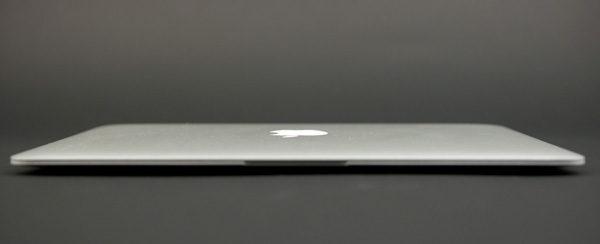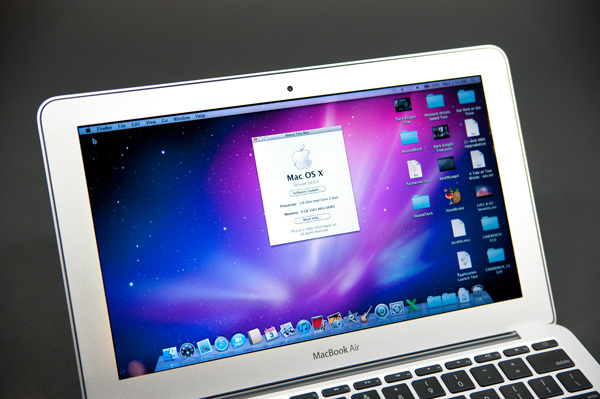Apple's 11-inch Upgraded MacBook Air: Do 1.6GHz and 4GB Make a Difference?
by Anand Lal Shimpi on November 6, 2010 2:35 AM EST- Posted in
- Mac
- Apple
- MacBook Air
- Laptops
Last month we looked at Apple’s new 11-inch and 13-inch MacBook Airs. I concluded the 11-inch was the pinnacle of portability, delivering the weight and form factor of a netbook but without the drive-you-crazy performance of an Atom. The 13-inch was more of a regular, get-your-work done notebook - just in a very thin and very light chassis. I liked carrying the 11-inch MBA, but I liked working on the 13-inch. My typical workflow was simply too slow on the 1.4GHz 11-inch system.
Apple offers two potentially important upgrades for the 11-inch MacBook Air that could alleviate some of my concerns. For $100 more than its $999 starting price, you can outfit the 11 with 4GB of memory instead of 2GB. Light web browsing and writing don’t need more than 2GB, but start editing videos, photos or open way too many apps at once and you’ll quickly want more memory. If you’re planning on keeping your system for a while, the 4GB upgrade makes a lot of sense. And many Apple stores actually stock the upgraded 4GB model.
The next upgrade is a bit harder to swallow. The base 11-inch MacBook Air can’t be upgraded aside from memory. The $1199 model however, can. You get a 128GB SSD (up from 64GB) as well as the option to pay $100 for a 1.6GHz Core 2 Duo.
Normally 200MHz isn’t much to write home about, especially not for $300 more than the standard 11. However, 200MHz is a 14% increase in clock speed compared to the base model. In applications that are CPU bound, you may see close to that percentage in improved performance. The magic number for feeling a performance increase is 10%. Anything below that is tough to feel in real world use, but anything at or above that 10% mark usually feels quicker.
| MacBook Air Spec Comparison | |||||
| 11-inch | Upgraded 11-inch | 13-inch | |||
| CPU | Intel Core 2 Duo 1.4GHz | Intel Core 2 Duo 1.6GHz | Intel Core 2 Duo 1.86GHz (2.13GHz optional) | ||
| Memory | 2GB DDR3-1066 soldered on-board | 4GB DDR3-1066 soldered on-board | 2GB DDR3-1066 soldered on-board (4GB optional) | ||
| GPU | NVIDIA GeForce 320M | NVIDIA GeForce 320M | NVIDIA GeForce 320M | ||
| Storage | 64GB SSD | 128GB SSD | 128GB SSD (256GB optional) | ||
| Connectivity | 802.11a/b/g/n Bluetooth 2.1 + EDR | 802.11a/b/g/n Bluetooth 2.1 + EDR | 802.11a/b/g/n Bluetooth 2.1 + EDR | ||
| Battery Capacity | 35 Whr | 35 Whr | 50 Whr | ||
| Dimensions | 11.8 " x 7.56 " x 0.11 - 0.68" (29.95 cm x 19.2 cm x 0.3 - 1.7 cm) |
11.8 " x 7.56 " x 0.11 - 0.68" (29.95 cm x 19.2 cm x 0.3 - 1.7 cm) |
12.8 " x 8.94 " x 0.11 - 0.68" (32.5 cm x 22.7 cm x 0.3 - 1.7 cm) |
||
| Weight | 2.3 lbs (1.06 kg) | 2.3 lbs (1.06 kg) | 2.9 lbs (1.32 kg) | ||
| Price | $999 | $1399 | $1299 | ||
Combine the two upgrades and you’ve got a fairly expensive MacBook Air ($1399 if you’re keeping score). But if you want the portability of the 11 and are looking to get as much performance as possible, it’s your only option.
Luckily we happened to come across such a system. And we didn’t hesitate to test it.












85 Comments
View All Comments
melgross - Saturday, November 6, 2010 - link
I don't know. The tests seem to be pretty clear on this. And as for noticing theerformance increase, sure, under most conditions you should.
Look, we've seen crazy PC overclockers pay hundreds for a 10% increase in cpu speed which translates most of the time to a useless 5% performance increase, totally unnoticable. A pretty big industry surrounds this overclocking, overpriced "enthusiast" chip market. At least here, you're getting the increase in performance you're paying for, and it's not really that much, considering what SSD's go for.
B3an - Saturday, November 6, 2010 - link
Wow completely not understanding the overclocking market. .Some enthusiast overclockers will pay high amounts, but the vast majority of overclockers get a normal CPU that has an average price, maybe even below average price, then they overclock it. A lot of CPU's these days OC very well and will manage a lot more than a 10% performance increase from an OC even with average air cooling. You can see this yourself in countless CPU reviews.
Most overclockers can get there mid-range priced PC performance matching a high end and way more expensive Mac. Not to mention also have things like USB3.0 support which still is not available for any Mac, and the latest graphics cards in there system.
I'm actually an "enthusiast", so in the minority of the OC-ing crowd (but i actually use my PC for work mostly), but even my expensive system does not cost more than Apples top machines, yet it has faster RAID SSD's, more RAM (24GB) which is also faster, up to date dual GPU's (5870's), i've gained over 1.2GHz in CPU speed from an OC - no small performance incease, and it has all round higher quality components including a vastly higher quality case and power supply than anything Apple sells.
Infact it costs less than apples highest priced Mac Pro, which ONLY has 6GB RAM and a single ATI 5770. Thats just... beyond ridiculous, theres not even a word for it.
I'd also like to point out that the 24GB RAM that i have was under £500 ($800), now if i was to get the 24GB upgrade on Apples site for the Mac Pro, it would cost... £2040.00 ($3,300). It's also slower RAM! For that price you could buy a WHOLE PC with similar specs to a Mac Pro.
Anand Lal Shimpi - Saturday, November 6, 2010 - link
Agreed, I clarified the statement in the article. You get a 15% improvement in performance when you need it and don't pay too much (at least in terms of battery life) when you're looking for max lifespan.If you sat there and ran Cinebench all day the impact on battery life would be more in line with the performance improvement.
Take care,
Anand
casteve - Saturday, November 6, 2010 - link
Just wondering...if the larger capacity SSD is built with additional RAM chips rather than just larger RAM chips, then the additional read/write channels could be a major influence on the test results...tipoo - Saturday, November 6, 2010 - link
Yeah I was thinking the same. Any chance you'll run the SSD benchmarks again on the larger one?tipoo - Saturday, November 6, 2010 - link
Oh, and if you do could you throw the SSD results from the Adamo in there?pixelhaus - Saturday, November 6, 2010 - link
I don't get the MBA.1) Upgrading the RAM is basically mandatory at the time of purchase because it cannot be bumped up at a later time; 2 GB simply isn't good enough to insure a decent computing experience unless all you ever really do is IM/chatting and light browsing (in which case, you should probably look at a $300 netbook). That $100 to bump the RAM is more or less a hidden fee.
2) A fully upgraded 11-inch model with 4 GB of RAM, 128 GB SSD and 1.6 GHz CPU is $100 more expensive than a 13-inch model with a 1.86 GHz CPU (128 GB SSD, but only 2 GB of RAM); how does that make any sense?
3) I understand the Air is about portability, but comparing it to other Apple notebooks, it seems you sacrifice an awful lot for the price; I guess that's moot if you're on the market for an ultra portable, but it doesn't sit well with me that an Air with proper RAM and CPU is as expensive as a much more powerful 15-inch MBP.
4) The 11-inch model really is a $999 netbook; the 1.4 GHz C2D CPU is indeed more powerful than a lowly Atom, but in the end it's not adequate for much more than what you'd typically do with a netbook.
7Enigma - Monday, November 8, 2010 - link
That's my thinking as well. Unless you are completely infatuated with the 11", the 13" seems to be the obvious choice when comparing these 2. If you then use the "extra" $100 to bump up the 13" to 4GB of ram the performance would likely increase even more compared to the upgraded 11". And this doesn't even take into consideration the almost DOUBLING of battery life in the light-web browsing test.So basically unless you NEED to have the 11" there is absolutely nothing in it's favor when compared to the 13" IMO.
dagamer34 - Saturday, November 6, 2010 - link
In other words, the MacBook Air continues to be a waste of money if you even slightly care about performance. Yay!jameskatt - Saturday, November 6, 2010 - link
You forgot to mention that based on Anandtech's numbers, you get a 45% more battery life when you do not use Flash!!!!!WOW!!!
This is one primary reason to leave Flash out of Mac OS X.
This is true across all of the Mac Laptops tested.
This proves how much of a power hog Flash is.